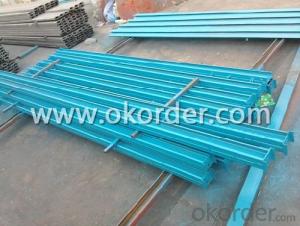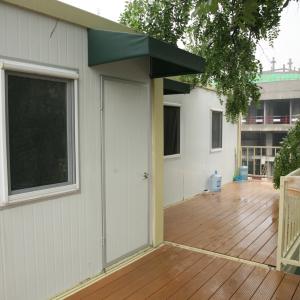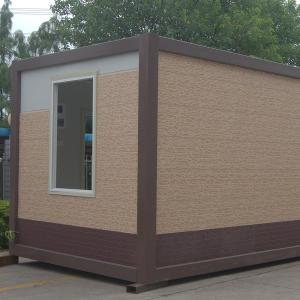Modular Container Home
- Loading Port:
- China Main Port
- Payment Terms:
- TT OR LC
- Min Order Qty:
- -
- Supply Capability:
- -
OKorder Service Pledge
OKorder Financial Service
You Might Also Like
Container House & HOME
Lifetime | 20-25 years |
Steel Frame | 4mm thickness steel pillar (baking finish)+3mm steel beam (Hot-galvanized) |
Wall Panel | 60mm EPS/Rockwool/PU sandwich panel |
Roof | (1)First layer: 0.5mm Hot-galvanized steel sheet (2)Second layer: 100mm glass wool insulation (3)Third layer: 50mm EPS/PU/Rockwool Sandwich Panel |
Bottom | (1)First layer:1.8 mm PVC floor (2)Second layer:18mm plywood for office,living etc. Cement fiberboard for bathroom with good water-proof (3)Third layer:100mm Insulation (4)Forth layer:0.5mm Hot-galvanized steel sheet |
Door/windows | one steel door and two PVC sliding windows |
Electricity | (1)1 distribution box;1 circuit breaker; (2)2 Ceiling lights ; 3 sockets(1 is A/C socket); (3)1 switch; |
Usage | Accommodation,office,living room,hotel,meeting room, dormitory, shop, booth, toilet, storage, kitchen, shower room and so on. |
Package | (1) 4 sets Flat-packing without shipping container (2) 6 sets loading in 40'High shipping Container; (3)The inner shower room and other furniture will be packed separately in shipping container.
|
- Q: Are container houses suitable for co-living or shared housing?
- Yes, container houses are suitable for co-living or shared housing. They can provide affordable and sustainable housing options for multiple individuals or families. With their compact design and modular nature, container houses can be easily customized and adapted to accommodate shared living spaces, ensuring privacy and comfort for each resident. Additionally, container houses can be easily transported and set up in various locations, making them a flexible solution for co-living communities or shared housing initiatives.
- Q: Are container houses suitable for DIY construction?
- Yes, container houses are suitable for DIY construction. One of the main advantages of container houses is their simplicity and ease of construction. The structure of the containers is already in place, making it easier for individuals with basic construction skills to assemble and modify them according to their needs. Additionally, container houses often come with pre-cut openings for windows and doors, reducing the need for complex cutting and framing. Moreover, containers are designed to be transported and stacked, which means they can be easily moved around and assembled on-site. This flexibility allows DIY builders to construct their container houses at their own pace and in their desired location. However, it is important to note that while container houses can be suitable for DIY construction, it is still essential to have proper knowledge, skills, and safety precautions to ensure a successful and safe construction process.
- Q: Are container houses resistant to vandalism?
- Container houses can be resistant to vandalism as they are made of sturdy materials like steel that are difficult to break into. However, the level of resistance may vary depending on the specific design and security measures taken.
- Q: Can container houses be designed with unique architectural features?
- Yes, container houses can definitely be designed with unique architectural features. Despite their compact and modular nature, architects and designers have found innovative ways to transform shipping containers into visually appealing and distinctive homes. From adding additional windows, skylights, or balconies, to incorporating unique exterior cladding materials, creative floor plans, and interior design elements, container houses can be customized to reflect individual tastes and preferences, making them truly unique in their architectural features.
- Q: Are container houses suitable for music or recording studios?
- Container houses are a viable option for creating music or recording studios, as they provide a wide range of benefits. Firstly, their high customizability allows for the modification of the interior layout to suit the specific needs of a studio. Ensuring excellent sound insulation is crucial, and container houses can be designed with specialized materials to prevent sound leakage and external noise infiltration. Furthermore, container houses are cost-effective. Compared to traditional construction methods, they are generally cheaper to build or convert into a music studio. This affordability is particularly advantageous for independent musicians or small recording studios with limited budgets. In addition, container houses offer portability and flexibility. They can be easily transported to different locations, enabling musicians or recording studios to have a mobile setup. This flexibility proves beneficial for those who frequently need to change their environment or move to different recording spaces. Moreover, container houses are environmentally friendly. By repurposing shipping containers, the demand for new construction materials is reduced, and waste is minimized. This eco-friendly approach aligns well with the values of many musicians and recording studios. However, it is important to address certain limitations when considering container houses for music or recording studios. The small size of a single container may necessitate connecting multiple containers to create a larger studio space. Additionally, adequate ventilation, temperature control, and electrical supply should be carefully considered during the design process. In conclusion, container houses offer a unique and innovative solution for musicians and recording studios seeking a creative and functional space. Their customizability, cost-effectiveness, portability, and eco-friendliness make them suitable options, despite some limitations that can be overcome with proper planning and design.
- Q: Can container houses be designed with a tropical or beach theme?
- Certainly, container houses have the potential to be designed with a tropical or beach theme. The extensive flexibility of container homes allows for an infinite array of design options and aesthetics. To achieve a tropical or beach-themed container house, several essential elements can be integrated. To begin, the exterior of the container house can be adorned with lively, tropical hues such as turquoise, coral, or sunny yellow, effectively capturing the essence of the beach theme. Additionally, the inclusion of features like palm trees, tropical plants, or even a small sandy area surrounding the house can enhance the overall tropical ambiance. Within the container house, the design can be further elevated to emanate a tropical or beach atmosphere. This can be accomplished by employing materials like bamboo or driftwood for furniture, flooring, or wall coverings. The incorporation of nautical or beach-inspired decorations, such as seashells, netting, or beach artwork, can also contribute to the overall thematic coherence. Furthermore, incorporating large windows and open floor plans into the design can optimize natural light and establish a seamless connection between the indoor space and the outdoor surroundings. This will allow residents to relish the tropical views and refreshing breeze while inside the container house. In terms of functionality, container houses can be equipped with features that suit tropical or beach environments. For instance, installing an outdoor shower or a small pool can provide a rejuvenating way to cool off in the tropical heat. Prioritizing the use of sustainable and eco-friendly materials can also align the container house with its natural surroundings and promote an environmentally conscious lifestyle. In conclusion, container houses can be designed with a tropical or beach theme by incorporating vibrant colors, natural materials, nautical decor, and functional elements. With thoughtful planning and creative execution, container homes can offer a distinctive and stylish living space that perfectly complements a tropical or beach environment.
- Q: Can container houses be suitable for all climates?
- Container houses have the potential to be suitable for a wide range of climates; however, their suitability may vary depending on the specific conditions of each climate. Containers possess inherent durability and weather resistance, making them a favorable choice for many climates. Nonetheless, it may be necessary to make certain modifications and considerations to ensure their suitability in extreme climates. In colder climates, insulation can be applied to container houses to prevent heat loss and maintain comfortable temperatures indoors. Enhancing thermal performance can be achieved by adding additional insulation materials, such as foam or fiberglass, to the walls, floors, and ceilings. Double-glazed windows and doors can also aid in retaining heat and minimizing drafts. Proper ventilation systems should be installed to prevent moisture buildup, which can result in condensation and potential mold problems. In hotter climates, appropriate insulation can help keep the interior of container houses cool. Light-colored or reflective roofs can assist in reflecting sunlight and reducing heat absorption. Adequate shading and ventilation options, such as awnings, shades, or fans, should be implemented to encourage airflow and prevent overheating. Additionally, installing energy-efficient air conditioning systems can enhance comfort during hot seasons. In climates with high humidity, preventing moisture buildup is of utmost importance. Proper ventilation and dehumidification systems should be implemented to reduce humidity levels and prevent the growth of mold and mildew. Insulation should be moisture-resistant to avoid trapping moisture within the walls. In regions prone to strong winds or hurricanes, reinforcing container houses to withstand these conditions is crucial. Additional bracing and anchoring can be added to ensure structural integrity. Impact-resistant windows and doors can be installed to offer protection against flying debris. It is imperative to seek guidance from professionals who have experience in designing container houses for specific climates. They can provide valuable expertise and advice on the necessary modifications and considerations to ensure the suitability and comfort of container houses in various climates.
- Q: Can container houses be designed with a small footprint?
- Yes, container houses can definitely be designed with a small footprint. In fact, one of the major advantages of using shipping containers as building units is their ability to be stacked and arranged in various configurations, maximizing the use of limited space. By designing container houses with a small footprint, we can ensure that they occupy minimal land area, making them ideal for urban environments or areas with limited space availability. To achieve a small footprint, several design strategies can be employed. Firstly, containers can be stacked vertically instead of horizontally, allowing for multi-level structures that utilize the vertical space efficiently. Additionally, modular container units can be interconnected, creating compact structures that can be expanded or modified as needed. Another way to reduce the footprint is by incorporating space-saving features and smart design elements. This includes utilizing open floor plans, multi-purpose furniture, and maximizing natural light and ventilation to reduce the need for excessive energy consumption. By carefully considering the layout and organization of the container house, we can ensure that every inch of space is utilized effectively. Furthermore, container houses can be designed with sustainable features that reduce their environmental impact. This can include incorporating solar panels for energy generation, rainwater harvesting systems, and utilizing eco-friendly materials for construction. By focusing on sustainability, we not only reduce the carbon footprint of the container house but also promote a more environmentally friendly lifestyle. In conclusion, container houses can indeed be designed with a small footprint by utilizing vertical stacking, modular construction, space-saving features, and sustainable design elements. These houses offer a practical solution for maximizing space efficiency while reducing environmental impact, making them a viable option for those seeking compact and eco-friendly housing solutions.
- Q: Are container houses hurricane-resistant?
- Container houses have the potential to be hurricane-resistant when they are designed and built appropriately to endure extreme weather conditions. Housing containers are typically constructed using sturdy steel and possess a robust structure capable of withstanding strong winds and heavy rainfall. It is important to consider, however, that the level of hurricane resistance may vary depending on factors such as construction quality, foundation type, and house design. Enhancing the hurricane resistance of container houses can be achieved through various reinforcements, such as incorporating additional steel supports or employing reinforced concrete foundations. Furthermore, implementing protective measures like hurricane shutters or impact-resistant windows can offer additional defense against flying debris during hurricanes. Overall, by employing proper construction techniques and taking necessary precautions, container houses can withstand hurricane-force winds and provide a secure living environment in areas prone to hurricanes.
- Q: Are container houses affordable?
- Yes, container houses are generally considered to be affordable compared to traditional houses. The cost of building a container house can vary depending on factors such as size, design, location, and the level of customization. However, in general, container houses tend to be more cost-effective because the main structure is already in place, which reduces construction time and labor costs. Additionally, shipping containers are readily available and can be purchased at relatively low prices. Moreover, container houses have lower maintenance costs due to their durable and weather-resistant nature. Overall, container houses offer a more affordable housing option for those looking for an alternative to conventional homes.
Send your message to us
Modular Container Home
- Loading Port:
- China Main Port
- Payment Terms:
- TT OR LC
- Min Order Qty:
- -
- Supply Capability:
- -
OKorder Service Pledge
OKorder Financial Service
Similar products
Hot products
Hot Searches
Related keywords























